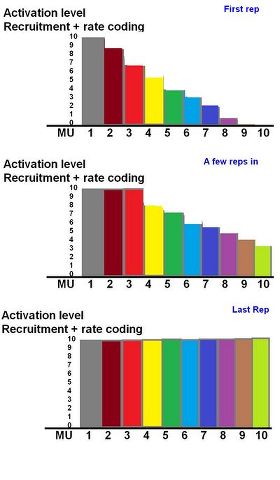So I'm going to invent an experiment in order to illustrate the HST idea of relative tissue conditioning and using load as a means of increasing stimulation.
Imagine we have 5 different groups who are 1) all trained people, with randomization etc. properly performed and 2) have taken a couple week break before our training experiment and 3) we know their RM's for 60-75% 1 RM.
Group 1 = 60% 1 RM, 3 sets to failure performed twice per week for a total of 4 weeks. Load remains static all 4 weeks, more reps performed if possible.
Group 2 = 65% 1 RM, 3 sets to failure performed twice per week for a total of 4 weeks. Load remains static all 4 weeks, more reps performed if possible.
Group 3 = 70% 1 RM, 3 sets to failure performed twice per week for a total of 4 weeks. Load remains static all 4 weeks, more reps performed if possible.
Group 4 = 75% 1 RM, 3 sets to failure performed twice per week for a total of 4 weeks. Load remains static all 4 weeks, more reps performed if possible.
Group 5 = 60% 1 RM, 3 sets to failure performed twice in week 1. 65% 1 Rm, 3 sets to failure performed twice in week 2. 70% 1 RM, 3 sets to failure performed twice in week 3. 75% 1 RM, 3 sets to failure performed twice in week 4. More reps performed on the 2nd session of each week if possible.
If I had to guess, I don't know that Group 1-4 would have any different results at the end of 4 weeks. I suspect they wouldn't. But the HST hunch/guess is that group 5 would outperform the other groups, because of the effect of relative tissue conditioning. Repeated bout effect might be the wrong word, it could be anabolic resistance, but if part of what we're adapting to is the load itself in our training sessions, then group 5 is the only one that would be trending towards staying ahead of the adaptive curve.
So another way of asking what I've asked in this thread is, what do you think the results would be? I'm honestly not sure, but if I had to guess if any of these groups were to win, my money would probably be on group 5.
Imagine we have 5 different groups who are 1) all trained people, with randomization etc. properly performed and 2) have taken a couple week break before our training experiment and 3) we know their RM's for 60-75% 1 RM.
Group 1 = 60% 1 RM, 3 sets to failure performed twice per week for a total of 4 weeks. Load remains static all 4 weeks, more reps performed if possible.
Group 2 = 65% 1 RM, 3 sets to failure performed twice per week for a total of 4 weeks. Load remains static all 4 weeks, more reps performed if possible.
Group 3 = 70% 1 RM, 3 sets to failure performed twice per week for a total of 4 weeks. Load remains static all 4 weeks, more reps performed if possible.
Group 4 = 75% 1 RM, 3 sets to failure performed twice per week for a total of 4 weeks. Load remains static all 4 weeks, more reps performed if possible.
Group 5 = 60% 1 RM, 3 sets to failure performed twice in week 1. 65% 1 Rm, 3 sets to failure performed twice in week 2. 70% 1 RM, 3 sets to failure performed twice in week 3. 75% 1 RM, 3 sets to failure performed twice in week 4. More reps performed on the 2nd session of each week if possible.
If I had to guess, I don't know that Group 1-4 would have any different results at the end of 4 weeks. I suspect they wouldn't. But the HST hunch/guess is that group 5 would outperform the other groups, because of the effect of relative tissue conditioning. Repeated bout effect might be the wrong word, it could be anabolic resistance, but if part of what we're adapting to is the load itself in our training sessions, then group 5 is the only one that would be trending towards staying ahead of the adaptive curve.
So another way of asking what I've asked in this thread is, what do you think the results would be? I'm honestly not sure, but if I had to guess if any of these groups were to win, my money would probably be on group 5.
Last edited:

